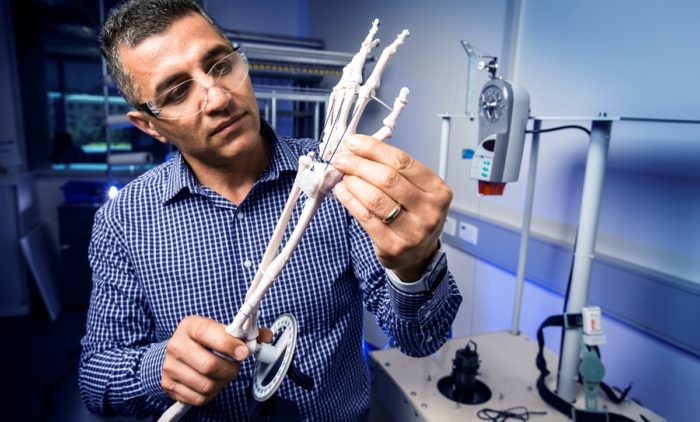News
3D printing bone tissue
Jun 28 2022
Putting ‘socks’ on helps artificial muscles made from inexpensive materials produce 40 times more flex than human muscle, a global research project has found, featuring ARC Centre of Excellence for Electromaterials Science (ACES) researchers from the University of Wollongong (UOW).

Researchers from ACES’ lead node at UOW’s Intelligent Polymer Research Institute including Professor Geoff Spinks, Dr Javad Foroughi, Dharshika Kongahage and Sepehr Talebian, joined with international partners from the USA, China and South Korea to develop sheath-run artificial muscles (SRAMs), that can be used to create intelligent materials and fabrics that react by sensing the environment around them.
ACES researcher and ARC-DECRA Fellow Dr Javad Foroughi said these new muscles build on the team’s work over the past 15 years in artificial muscle performance.
“I discovered as part of my PhD project that giant torsional actuation in twisted carbon nanotube yarns can be used as artificial muscles, and since then Professor Spinks and I have been working on a new generation of artificial muscles that furthers this research,” Javad said.
“This will be our fourth paper published in Science since this discovery in 2008, which is incredibly exciting and great recognition for the team and the potential for real applications these artificial muscles hold.”
The sheath-run artificial muscles feature a sheath around a coiled or twisted yarn, which contracts, or actuates, when heated, and returns to its initial state when cooled. The outside sheath absorbs energy and drives actuation of the muscle. The muscles can also operate by absorbing moisture from their surroundings.
The new SRAMs are made from common natural and man-made fibres, such as cotton, silk, wool and nylon, which are cheap and readily available.
ACES Chief Investigator Professor Geoff Spinks said the team wanted to improve upon its previous artificial muscle work, which relied on coiling and twisting more sophisticated materials like carbon nanotube yarn.
“While there’s no doubt carbon nanotubes make wonderful artificial muscles, CNT is also a very expensive product. Our latest work utilises inexpensive, commercially available yarns with a CNT polymer coating for the sheath,” Geoff said.
“Previously, we were applying energy to the entire muscle, but only the outer part of the fibre was responsible for actuation. By placing a sheath on the muscle, we can focus only that energy on the outer part of the fibre, and convert this input energy more quickly and efficiently.”
Javad explained that the application possibilities for SRAMs are diverse.
“When we talk artificial muscles, we’re not just talking about a technology as a replacement for muscles in the body. These muscles offer some exciting opportunities for technologies where the artificial muscles intelligently actuate by sensing their environment,” Dr Foroughi said.
“Picture these muscles being woven into comfort-adjusting textiles that cool in summer and warm in winter depending on their exposure to temperature, moisture (like sweat), and sunlight, or as smart controlled drug release devices for localised delivery through the actuation of valves that control the flow of liquids depending on their chemical composition or temperature.”
ACES Director Professor Gordon Wallace said this work is an excellent example of the importance of global collaboration in delivery efficient, effective and high impact advances in research and innovation.
“The success of our Centre’s work on artificial muscles is the result of our highly skilled researchers being important contributors to a diverse and multidisciplinary team assembled from across the globe. Building these links enables the realisation of exciting new technologies,” Professor Wallace said.
This work is published in the journal Science, and includes collaboration by the University of Wollongong, The University of Texas at Dallas (USA), Donghua University (China), and Hanyang University (South Korea).













